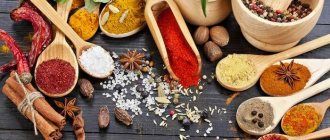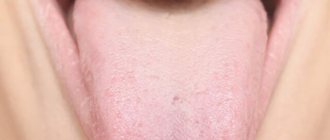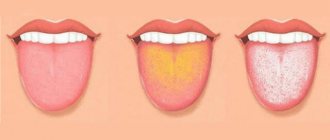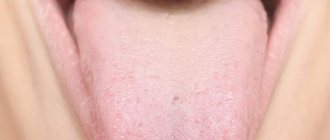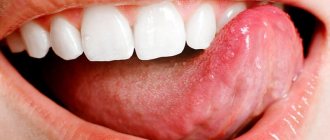The state of the tongue reflects the state of the human body. That is why almost any doctor during an examination asks the patient to show his tongue. In a healthy person, the tongue has a pale pink color, pronounced papillae, and a straight fold exactly in the center. It should be soft to the touch, and moving it should not cause discomfort or pain. If you find that you have a white tongue, then there is a high probability of certain problems in the body. In this article we will talk about how dangerous the appearance of plaque on the tongue is, what causes and diseases lead to changes in the condition of the organ, and how this problem can be avoided and eliminated.
Anatomy: what does the tongue consist of?
The tongue is an organ that is part of the digestive system. It performs several functions:
- plays an important role in the formation of speech;
- helps form a bolus of food in the mouth and push it into the esophagus;
- helps us determine the taste of food.
What does language consist of? The organ is conventionally divided into two parts:
- the body of the tongue is the anterior movable part;
- The root of the tongue is the back part located closer to the larynx.
The tongue has a mucous surface on which taste buds are located, thanks to which we distinguish different tastes.
How to clean your tongue
If you don't have any health problems that affect the plaque, just follow these guidelines and remember to brush until all the plaque is removed and your tongue is pink again. Typically, tongue hygiene takes only 20–30 seconds.
Recommendations for adults
- Proceed with the procedure only after brushing your teeth
and rinsing your mouth. - Use special tools
: scrapers, nozzles and others. - Clean your tongue using sweeping movements
and light pressure. - Start from the root of the tongue
and end with the tip. - Do not brush your tongue with cross movements and do not press
too hard - this can damage it. - Don't forget to clean the instrument
after the procedure. - Be sure to rinse your mouth
with water.
Should children have their tongues cleaned?
Children also need tongue care, but not earlier than 3–4 years.
For younger children, tongue cleaning is pointless. They don’t eat junk food, especially not in the same quantities as adults, and they don’t drink tea and coffee. Until 3–4 years of age, normal oral care is sufficient. From 3–4 to 8 years
This is how you should clean your tongue.
- Move from the root of the tongue to the tip
with smooth sweeping movements, with even weaker pressure than with adults. - Similarly, clean the sides
of the tongue and the inside of the cheeks. - Be sure to rinse your mouth
.
From the age of 8
you can already use scrapers.
What does plaque on the tongue mean?
At different periods of time, the appearance of the tongue may change, and a coating on the tongue that has a whitish color is acceptable in a small amount. At the same time, the papillae are clearly visible through it. In summer, the thickness of the plaque may increase, and in winter it may acquire a yellowish tint.
When should you worry about tongue coating?
- if the tongue is constantly coated;
- the plaque becomes dense and completely hides the mucous membrane;
- the papillae of the tongue are poorly visible;
- the color of the tongue has changed (excessive pallor, redness, blueness);
- the plaque has a dense cheesy structure;
- unusual color of plaque - yellow, green, brown, gray, black.
With such signs, we can talk about both dental pathologies and more serious problems - acute and chronic diseases of internal organs. To get rid of plaque on the tongue, you first need to find out the reason for its appearance.
The first step is a consultation with a dentist. Based on the results of the examination, the doctor will accurately determine whether the coated tongue is associated with caries, diseases of the oral cavity, and if not, he will refer you to other highly specialized specialists.
Why do you need to clean your tongue?
The benefits of tongue cleaning will be noticeable if the procedure is carried out regularly and correctly. Such care is especially important if there is a thick, dense coating of yellow, gray or brown color that has an unpleasant odor. These signs may indicate:
- infectious diseases - sore throat;
- fungal infections of the oral mucosa - candidiasis;
- pathologies of the digestive system;
- disorders of intestinal microflora;
- helminthic infestations;
- long-term use of certain medications;
- unbalanced diet;
- insufficient oral care.
Cleaning not only provides a fresh smell, but also gets rid of many pathogens. Its regular implementation allows you to get rid of tartar and other dental diseases. The procedure stimulates the functioning of internal organs and helps to better perceive the taste of food dishes.
Why does plaque form on the tongue?
The most common and easily eliminated reason for the formation of white plaque on the tongue is poor oral hygiene.
However, there are other factors that influence the condition of the tongue. Among them:
- infectious diseases in the oral cavity (stomatitis, etc.);
- acute, chronic diseases and disorders of the gastrointestinal tract;
- respiratory diseases;
- infectious diseases;
- parasitic infection;
- candidiasis;
- kidney diseases.
Whether it is worth worrying about the health of certain organs can be judged by the color, nature and location of plaque on the tongue.
Taking medications
A yellow coating on the tongue may appear from constant use of antibiotics.
Often people notice the appearance of a layer of yellow coating on the tongue after taking vitamin complexes.
This should not be alarming, since the coloring of the tongue occurs due to the pigment substances contained in such preparations.
The phenomenon is temporary. Long-term use of antibiotics can also cause yellow plaque spots.
The reason for this is that the liver is overloaded with various chemicals that need to be processed, as a result of which the organ works in too intense a mode, releasing a certain amount of toxic substances into the body.
It should be noted here that medications themselves are in no way a factor in the occurrence of plaque; when taken, they negatively affect the functioning of the digestive organs, and it is disturbances in the food processing processes that affect the coloration of the tongue yellow.
White coating on the tongue - what is it?
The main cause of plaque is poor hygiene and the resulting pathological conditions of the oral cavity. Therefore, first of all, you should see a dentist with such a problem.
In some cases, you can independently differentiate its causes by the color and location of the plaque. For example, why is the tongue white?
- 1
A white coating at the base of the tongue (in the root area) indicates high activity of bacteria or fungi. This may be due to both problems in the oral cavity and disturbances in the functioning of the intestines and other organs of the gastrointestinal tract. - 2
A thick white coating on the tongue is usually caused by an infection of the tonsils, respiratory tract or gastrointestinal tract.
- 3
A white, cheesy coating on the tongue is a sign of candidiasis (thrush).
- 4
A white coating on the tongue, as well as on the mucous tissues of the oral cavity, indicates stomatitis.
Children's diagnostics
A comprehensive examination will help determine the cause of yellow spots on the tongue.
A visual examination of the oral cavity alone is not enough to identify the true causes of the formation of yellow plaque.
Without additional diagnostics, even the most highly qualified physician cannot cope with this task. This is due to the fact that this symptom may indicate the presence of a wide variety of disorders.
That is why a comprehensive examination is carried out, a complete clinical picture is outlined and more in-depth studies are prescribed by a pediatrician, specialists in the field of gastroenterology, and dental care.
Yellow coating on the tongue
If your tongue turns slightly yellow in hot weather, there is no cause for concern. An alarming sign is the formation of a pronounced yellow coating on the tongue, which most often indicates serious disturbances in the functioning of the liver, gall bladder, and other pathologies of the digestive system.
Why is the tongue yellow?
- A small yellow plaque that appears in the morning and is easily removed during standard teeth brushing may indicate intoxication of the body (metabolic disorders, excess toxins). If the tongue remains clean for several hours after the procedure, then it really is a matter of toxins. To get rid of plaque, the patient needs to change his diet in order to normalize the functioning of the digestive system.
- Yellow plaque, loose in structure, combined with a specific taste and bad breath is a sign of serious disorders in the functioning of the gastrointestinal tract, requiring appropriate diagnosis and treatment. If such plaque appears, you need to contact a gastroenterologist.
- Yellow plaque in tandem with a high temperature may indicate inflammation of the ENT organs (pharyngitis, sore throat).
In addition, a yellow coating on the tongue inevitably appears in smokers, coffee and black tea drinkers.
How to remove plaque stains from the tongue
First, you need to carefully observe the rules of oral hygiene. Often, vigorous movements of the toothbrush are enough to remove the layer of plaque, after which it can disappear forever.
If after a few days your tongue remains clean and pink, then you don’t have to worry about this anymore, remembering to also clean your tongue while brushing your teeth.
An alarming sign may be the reappearance of plaque a few hours after cleansing. Then you need to seriously think about your health and what exactly triggered its appearance. Qualified help is needed otherwise the situation will get worse. It is necessary to observe the condition of your tongue for some time, and adhere to the following:
- In the morning and evening, carry out thorough oral hygiene, removing the layer of plaque, without overusing brushes with too hard bristles.
- Balance your diet, focusing on cottage cheese dishes and drinks with a high content of lactobacteria. Remove all junk food from your diet.
- You can use dietary supplements to stimulate the liver and improve the flow of bile. If the intensity of plaque on the tongue begins to fall, it means that the improvement in the quality of nutrition has had its effect; try to adhere to this lifestyle for a month.
- For respiratory diseases and anginal lesions, doctors recommend lubricating the tongue with emollient oils, such as peach. Thoroughly rinsing your mouth with tea leaves can also be effective. Rosehip extract can significantly improve the condition.
- If the reason is a disruption of the intestines, cleansing enemas and laxatives will help cope with the plaque, so you will get rid of accumulations of toxins. At the same time, it is also necessary to follow the principles of proper nutrition. However, it is better not to abuse these remedies and still resort to professional medical help.
Black coating on the tongue
Black plaque looks especially scary; it can occur with long-term use of antibiotics and a number of other medications, and can also indicate a number of diseases:
- infectious disease, in particular cholera;
- Crohn's disease;
- acidosis – PH disturbance;
- viral sore throat.
A dark tongue may have a purple tint, which indicates blood diseases, including anemia. A plaque with a blue tint is one of the symptoms of dangerous diseases such as dysentery and typhoid.
Diagnostics
Before a full examination is scheduled, the doctor examines the oral cavity using special medical instruments - a spatula. By the way the greenish coating looks and the enlarged taste buds of the tongue, by the relief surface of the muscular organ, as well as by the thickness of the accumulations and their location, it is not difficult for an experienced doctor to understand the causes of the unpleasant phenomenon. In addition, doctors often prescribe general tests, ultrasound and FGDS.
Adults should initially consult a therapist; children should be shown to a pediatrician. If necessary, patients are referred to the following specialists:
- Gastroenterologist;
- Dentist;
- Infectious disease specialist;
- Otolaryngologist;
- Pulmonologist;
- Endocrinologist;
- Toxicologist;
Such manipulation as removing plaque is very important. This prevents the development of pathogenic microflora and ensures healthy oral mucosa. By the way, clean crowns prevent the appearance of caries - another provoking factor for the appearance of accumulations on the tongue.
Why does the coating on the tongue have spots?
In most cases, spots on the tongue have nothing to do with dangerous conditions and diseases. However, it is imperative to find out their cause and pay attention to eliminating the causative factors.
What types of spots exist and why do they appear:
- the tip of the tongue turns red and goes numb - most likely this happened as a result of injury (burn from hot, spicy food, smoking), and problems in the intestines and heart are also possible;
- bright pink spots on the tongue - depending on the size and location, they can be caused by a deficiency of vitamin B12, folic acid or the development of scarlet fever, migratory glossitis;
- bright red spots on a pale tongue are a symptom of scarlet fever, but also appear against the background of anemia, in smokers;
- red dots combined with a whitish coating at the root of the tongue most likely indicate diseases of the digestive system.
Differentiation of plaque in gastritis from other diseases of the gastrointestinal tract
A thick, grayish coating is characteristic of dysentery.
It is important to suspect the onset of a dangerous disease in time. To take action and prevent complications from occurring. Differential diagnosis by tongue of gastritis from other diseases and conditions:
- A thick, grayish coating is characteristic of dysentery. In this case, the tongue looks cracked, and less saliva is produced than usual.
- Desquamative glossitis - this type of inflammation of the tongue is characterized by such symptoms as red spots of complete absence of epithelium or several altered taste buds on the tongue, covered with a white coating.
- Galvanic stomatitis is a form of inflammation of the tongue that arises as a result of a reaction to metal prostheses, manifested by spots in the form of pimples, and subsequently by the appearance of erosions against a background of white plaque.
- Infectious diseases - sore throat, scarlet fever, diphtheria, HIV infection can cause the appearance of a white coating on the tongue, but almost all of these infections are accompanied by high fever and skin rashes.
- Diseases of the heart and blood vessels - plaque is located on the anterior third of the tongue.
- Kidney disease - plaque on the tongue is localized at the back along the edges.
- Endocrine disorders - under the plaques of white plaque there are ulcers and erosions.
- Anemia is not a coating on the tongue, but blanching of the entire surface of the organ. Diseases of the respiratory system are often indicated by the localization of white plaque on the front and along the edges of the tongue.
- Diseases of the salivary glands - the appearance of a white coating is accompanied by the appearance of an unpleasant odor.
- Diseases of the liver and gall bladder - the color of the plaque is not white, but has a yellowish or brown tint. A white coating on the tongue can be caused by the consumption of dairy products, as well as the proliferation of bacteria and fungi in those who abuse sweets. Unlike plaque during gastritis, such layers are easily removed and do not form further.
How to remove plaque on the tongue?
- 1
Contact your dentist for advice. He will examine the oral cavity for dental diseases, carry out treatment if necessary (treatment of dental periodontitis, etc.), if plaque is associated with inflammatory processes in the oral cavity, and give recommendations on proper hygiene.
- 2
If the cause of the plaque is not related to dental health, the doctor will refer you to other specialists for examination.
What absolutely should not be done if plaque appears on the tongue:
- touch it with your hands;
- independently prescribe treatment for yourself, take medications without consulting a doctor;
- use solutions containing alcohol, iodine, hydrogen peroxide, brilliant green to clean the tongue;
- take vitamins without prior examination and doctor’s prescription.
In case of plaque or rashes on a child’s tongue, you need to be careful when planning your diet and do not introduce new foods, as they can provoke an allergic reaction and aggravate the situation.
How to get rid of plaque on the tongue?
- drink enough fluids, especially in hot, dry weather;
- to refuse from bad habits;
- introduce solid raw fruits and vegetables (apples, carrots) into the diet;
- take care of the health of the digestive system - adhere to a healthy diet, which will restore the intestinal flora, improve the functioning of the liver and pancreas, and normalize the acid-base balance;
- monitor the health of teeth and gums, undergo dental treatment on time;
- observe the rules of oral hygiene.
Yellow tongue or how to get rid of bad breath
Home Articles Popular information articles Nutrition and diets
Each of us, in the process of communicating with each other, notices that some people have bad breath, while others do not, some have bad breath and a tongue coated with a white-yellow coating, while others do not have this. And, interestingly, if there is a yellow coating on the tongue, there will definitely be bad breath!
Why does the tongue appear coated with a yellow coating and putrid odor from the mouth?
The cause of bad breath can be carious teeth, as well as diseases of the digestive system. Such diseases of the digestive system include, first of all, functional conditions of the valve apparatus of the stomach, when the contents of the stomach and intestines periodically reflux into the esophagus more than 2-3 times a day, especially at night, when you are in a horizontal position. This condition occurs when the sphincter apparatus of the stomach and esophagus is insufficient. The cause of episodes of reflux (or gastroesophageal reflux) of the contents of the stomach and (duodenogastric reflux) of the intestines can be observed due to poor nutrition (abuse of foods that cause a decrease in the tone of the sphincter apparatus of the stomach), taking medications of a similar effect (hypnotics, sedatives, antispasmodics, laxatives, etc.) frequent stress, prolonged physical activity, constipation, flatulence associated with increased intra-abdominal pressure. Reflux can also occur with alcohol abuse and smoking.
The presence of gastroesophageal functional reflux is a passing phenomenon, but when reflux is a consequence of organic disorders of the sphincter apparatus of the stomach and esophagus (esophagitis, gastritis, duodenitis, peptic ulcer, etc.), or damage to the brain or spinal cord, congenital or acquired, then in these cases we speak of gastroesophageal reflux disease (GERD). The main signs of functional insufficiency of the lower esophageal sphincter are heartburn, belching of food, pain in the stomach or chest area, a yellow coating on the tongue, the appearance of stains on the pillow after sleep, and rotten breath. The yellow color of the tongue is associated with the reflux of bile into the oral cavity (duodenooral reflux). The frequency of reflux increases in the evening and night hours. It has been established that in healthy people duodenogastric reflux is practically absent.
The presence of reflux leads to the development of diseases of the digestive system and not only; the reflux of contents from the stomach into the oral cavity leads to microaspiration into the tracheal cavity, which can affect the health of the respiratory system. Long-term microaspiration of contents often leads to the appearance of an obsessive cough, and subsequently to the development of lung diseases (chronic bronchitis, bronchial asthma...). Based on the above, it becomes clear that it is necessary to prevent functional diseases of the stomach and esophagus, and even more so to prevent the development of GERD, and when the first signs of gastroesophageal and duodenogastric reflux appear, it is necessary to take the most active measures to eliminate them.
Where to start, what should be recommended for patients with gastroesophageal reflux?
Nowadays, every person knows how to maintain health. Combating risk factors and preventing overstrain of the nervous system are not burdensome, truly accessible to everyone and highly effective. Physical education, proper nutrition, a rationally and intelligently structured lifestyle, work and rest schedule play an important role in them. Moreover, the final goal can be achieved only with comprehensive compliance with all recommendations throughout life. First of all, these include the complete abandonment of bad habits.
After eating at lunchtime, a walk is necessary and daytime sleep is allowed only after 1.5-2 hours. It is recommended to sleep with the head of the bed raised by at least 15-20 cm. You should avoid tight clothing, tight belts, and tight elastic bands of clothing. What happens if after a heavy meal a person lies down on his back? By the way, no animal sleeps on its back! With this position of the body, the gas bubble of the stomach moves to the front wall and not air, but acidic gastric contents are discharged into the esophagus. This is precisely the trigger mechanism for the development of gastroesophageal reflux.
Physical exercises should be with the exception of overstraining the abdominal muscles, deep bending, prolonged stay in a bent position, lifting weights of more than 6-7 kg on both hands. It is not recommended to inflate balloons or tubes with your mouth or engage in professional sports.
In terms of nutrition, you must adhere to a diet. You should limit or reduce the content of animal fats (cream, butter, fatty fish, pork, duck, lamb, cakes), increase the protein content, avoid irritating foods (strong broths, marinades, smoked meats, sour and irritating (pineapple) juices, tomatoes, citrus fruits, coffee, strong tea, chocolate, onions, garlic, alcohol, tobacco, spices), carbonated drinks. It is necessary to reduce the daily amount of food, and the number of meals can be increased. While eating, it is advisable not to be distracted or talk; food should be chewed thoroughly and not rushed. In addition, you should not eat before bed. Sleep is allowed 2-3 hours after the last meal. Patients with excess weight are recommended to reduce it.
The presence of reflux does not depend on age; it can also occur in children under one year of age. In the nutrition of children in the first months of life who are bottle-fed, special anti-reflux mixtures should be used, the peculiarity of which is a change in the ratio of casein and whey proteins towards casein, as well as the inclusion of thickeners in their composition (most often, carob gum.
Where to start drug therapy?
In children and adults in the initial stages of reflux development, it is necessary to start by taking a decoction of medicinal plants:
Oregano herb - 50.0 Plantain leaf - 40.0 Yarrow herb - 30.0 Linden blossom - 20.00
Brew 1 tbsp. for 250 water, leave for 2.5 hours, drink 1/2 cup 3 times a day 25 minutes before meals (dose for age 24 years). You need to take the herbal collection for 1 month. It is recommended to prescribe the collection for children from 2.5-3 months. Among medications, it is recommended to prescribe the drug Motilium. For adults (1 tablet x 3 times a day 15 minutes before meals for 10 days) and for young children in syrup, according to weight. This is the so-called symptomatic therapy; the main direction in treatment should be given to the disease that led to the appearance of pathological reflux. The presence of such complaints always requires contacting a gastroenterologist, who will prescribe the comprehensive necessary treatment. Functional disorders of the digestive system are a large group of diseases that are widespread in childhood and adulthood and have an ambiguous prognosis. In recent years, significant progress has been made in the treatment of functional disorders associated with the emergence of new effective drugs that regulate gastrointestinal motility. However, these remedies cannot provide a final solution to the problem: due to the significant role of the nervous system in the development of these diseases, their treatment must be comprehensive and carried out in collaboration with neurologists, psychologists, and psychoneurologists. Following our recommendations on this issue with a mandatory consultation with a gastroenterologist will help you get rid of bad breath and a coated tongue, and therefore improve your health.
Gastroenterological Center of the Chelyabinsk Region. Tel. to sign up for a consultation: 89026187717
Author: V.L.
Zemlyakov Printable version


